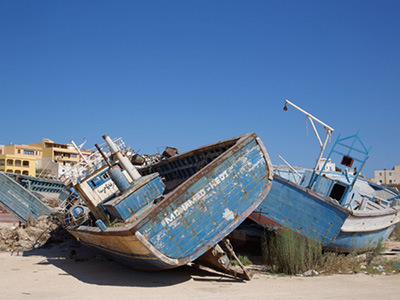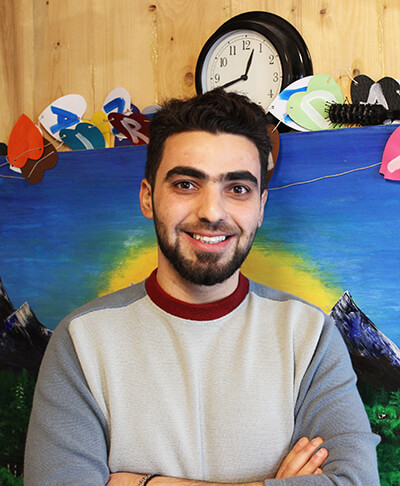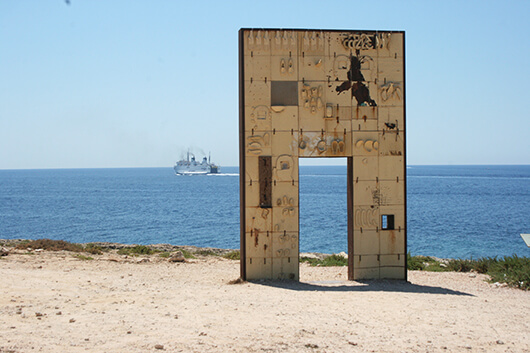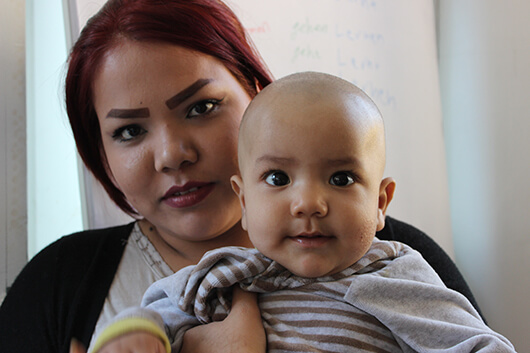
Rome is the epicenter of the Catholic Church, but there is much more to the Eternal City than papal authority and Baroque architecture. It has many of the same problems that cities face the world over. East of the Vatican lies Termini railway station. Here, the train tracks end. So does the hope of the refugee.
Each morning this summer, I have walked beside these tracks to my job at Joel Nafuma Refugee Center. Middle Eastern and African men, lying atop cardboard sleeping mats and beneath ancient aqueducts, line my commute. They watch me as I walk by.
At the center, I teach English in a small classroom beneath St. Paul’s Within the Walls Episcopal Church and converse daily with refugees, most of whom come for the hard-boiled eggs and ping-pong tournaments. Some kneel towards Mecca in the early afternoon. Others gather near a cross made of refugee boat wood salvaged from the Mediterranean. All are searching for work in a country that offers little. The doors close before sundown, and visitors return to their sidewalk dwellings at Termini.
I grew up in Omaha, Nebraska, home to the largest South Sudanese refugee population outside Africa. When I was a teenager, my dad took me downtown to talk with people who were living on the streets. In conversation with those on the periphery of my Omaha community, I noticed a deep joy within myself, one that has evolved and enlivened as I’ve explored my interests in college.
 Ahyan, a 23-year-old art student from Mosul, Iraq, makes his home in Salzburg, Austria, for now. Photo by Christopher Boldt ’18.
Ahyan, a 23-year-old art student from Mosul, Iraq, makes his home in Salzburg, Austria, for now. Photo by Christopher Boldt ’18.
Last summer, after finishing my freshman year at Notre Dame, I returned to Omaha to work eight weeks at my local homeless shelter through the Center for Social Concerns. Faces I had seen years earlier with my dad moved me, and I decided to use my opportunities at Notre Dame to go forth and meet other displaced peoples around the globe. During my sophomore year, I visited the United States-Mexico border, Salzburg, Austria, and the Italian island of Lampedusa, where I met many migrants and refugees whose suffering is too often forgotten in our world.
My travels began with a trip to the U.S.-Mexico border over winter break with a group led by Leo Guardado, a Notre Dame doctoral student in theology and peace studies. Our meetings with United States border patrol officers and humanitarians highlighted the week, but none moved me more than the stories of the migrants themselves.
One man told how he had fled gang violence in El Salvador, a country the U.S. media often dubs “the murder capital of the world.” After weeks traveling north through Mexico on foot and hidden inside farm trucks, his “coyote,” or guide, led him to group of armed men at the U.S. border. Pointing toward four bodies lying on the ground nearby, the group’s leader said to him, “Join them, or carry these bundles.” This kind of burden is often forced upon migrants at the border.
When drug trafficking is not threatening their lives, the Sonoran Desert is. Water is scarce in those beautiful panoramas. Dehydration kills hundreds of people each year.
In response, humanitarian groups like Samaritans and No More Deaths hike for miles in the heat to drop water jugs along remote trails. The U.S. Border Patrol, arguing that this water lures migrants, responds by slashing these water supplies. Local white supremacists, motivated by something other than national security, unofficially lend their hands to this effort. It is war at the border, and the weapons used are water jugs and the machetes that slice them.
After these local and national experiences, I set out to meet the displaced in other parts of the world. During spring break, I joined another group of students visiting Salzburg, Austria, with Notre Dame social ethicist Clemens Sedmak. Best known to many Americans as the setting of The Sound of Music and the birthplace of Mozart, Salzburg is now home to over 4,000 Syrian, Iraqi and Afghan refugees. One of them is Ahyan, a 23-year-old fine arts student from the University of Baghdad.
Abducted by ISIS militants from his home in Mosul, Iraq, Ahyan was ordered to fight for the terrorist organization. Choosing instead to flee, he escaped west into Syria, then Turkey. He crossed the Mediterranean Sea by boat to Greece and eventually made his way to Austria — “the only place,” he says, “where the police don’t hit us.”
These days, Ahyan fights his painful memories with boundless optimism, finding peace in his art. Inspired by the Austrian Alps, he paints the landscapes he sees around him every day.
Yet horrific memories continue to haunt refugees like Ahyan. One man showed me the room where he sleeps at a Red Cross camp. He keeps the blinds closed because the same views that inspire Ahyan remind him of the bodies he saw in the mountains of Eastern Europe. Another young man tightened up as he recalled the mass suffocation he barely survived in a human-trafficking truck, a disaster that claimed the lives of dozens of his friends. A third refugee, his voice quivering, expressed concern for his wife whom he’d left behind in Iraq. He had not heard from her in months.
Europe’s version of the Sonoran Desert is the Mediterranean Sea that separates Europe and north Africa. Refugee boat routes resemble migrant trails. Small islands function as border checkpoints. One of these is the tiny island of Lampedusa.
Lying about halfway between Libya and Sicily, Lampedusa has been a Mediterranean crossroads since ancient times. Greeks and Romans frequented the island to refill their hulls with fresh water, rabbit meat and wild herbs. Today, the island attracts other kinds of wayfarers. Tourists come to visit Lampedusa’s clear-water beaches. Refugees come to escape the terrors of Middle Eastern and north African societies.
 An Italian transport boat carries refugees past Lampedusa’s “Gateway to Europe.” Photo by Ilaria Schnyder von Wartensee.
An Italian transport boat carries refugees past Lampedusa’s “Gateway to Europe.” Photo by Ilaria Schnyder von Wartensee.
Earlier this summer, I traveled by myself to Lampedusa, where Professor Ilaria Schnyder von Wartensee of Notre Dame’s Ford Program in Human Development Studies and Solidarity introduced me to refugees from Gambia, Mali, Afghanistan, Liberia, Bangladesh and Sierra Leone. I listened to their hopes of becoming doctors and engineers, teachers and writers, mothers and fathers. Their optimism contrasted starkly with the despair I now see in Rome every day. The Lampedusan refugees do not yet know the cardboard dwellings I walk past every morning at Termini.
But all is far from idyllic for these refugees, even on Lampedusa. The alluring blue waters that surround it have attracted international concern. Some 400,000 migrants have landed on the island in the last two decades. Thousands more have drowned when their overcrowded boats or leaky rafts capsized or sank near its shores. The International Organization for Migration has called the central Mediterranean “the deadliest migration route in the world.” Pope Francis called attention to it when he visited the island in July 2013.
Standing behind an altar constructed of wood from a refugee boat, Francis said the human costs of the migration had become “a painful thorn” in his heart. “So I felt that I had to come here today, to pray and to offer a sign of my closeness,” he continued, “but also to challenge our consciences lest this tragedy be repeated. Please, let it not be repeated!”
Four months after the pope’s visit, the tragedy did indeed repeat itself. A boat carrying nearly 500 refugees capsized off Lampedusa, adding 359 people to the estimated 15 to 20 thousand who, according to the IOM, have died along this route since the year 2014.
Wrecked refugee boats are often towed to the shores of Lampedusa. Here, an Italian carpenter uses salvaged wood to create sacred chalices. One of these belongs to Pope Francis, another to Father Dan Groody, CSC, ’86, ’92M.Div., a Notre Dame theologian and international authority on immigration and globalization. I received a cross from that same carpenter during my visit. It hangs around my neck as a constant reminder of the suffering and forgotten displaced people in our world.
Pope Francis warns us against “the globalization of indifference”, an apathy toward suffering that he perceives permeating society today. Before these encounters with migrants and refugees from Omaha to Rome, I too was indifferent. Christ’s words, “I was a stranger, and you welcomed me,” held no meaning. But my experiences this year have globalized my encounter with human suffering, converting it into a concern for these migrants and refugees. If Thomas the Apostle, my namesake, needed to put his fingers in Jesus’ wounds in order to believe in him, then I needed to put my fingers into the wounds of humanity. We share the same resounding realization, “My Lord and my God!”
 An unnamed mother and child, residents of a camp near Bad Ischl, Austria. The U.N. estimates the world’s population of displaced persons at 65 million. Photo by Christopher Boldt ’18.
An unnamed mother and child, residents of a camp near Bad Ischl, Austria. The U.N. estimates the world’s population of displaced persons at 65 million. Photo by Christopher Boldt ’18.
I will return to Italy in the spring and summer of 2018 to participate in the International Scholars Program at Notre Dame’s Rome Global Gateway. The curriculum I created for myself includes an Introduction to the Quran course at the Pontifical Institute for Arabic and Islamic Studies, an internship with Jesuit Refugee Services and a research project that ties Notre Dame theologians to my work with refugees in Rome.
Back at Termini, a homeless man I have spoken with all summer says, “Tell USA no more sending to Afghanistan” and hands me a toy fighter jet. He says he lost his daughter to a U.S. military strike years ago that forced him to flee his home in search of a new life in Europe. He now lives separated from family and unemployed on the streets of Rome.
I don’t know how to respond to the gift from this suffering man, but I find meaning in our interaction and others like it. The ancient Greeks’ word for the bringing together of discrete entities gives us the English word “symbolic.” In this sense, the word describes this encounter of two people who once were strangers. The Greeks also gave us a related word: “diabolic.” It means “to separate and scatter.” Avoiding the stranger is diabolic. It divides me from my brother.
At summer’s end, I return to Notre Dame for my junior year with a toy fighter jet in hand and a vision of global change in my mind.
Thomas Doran is a junior studying theology with a minor concentration in philosophy, science, and mathematics and a minor in Catholic social tradition. His summer in Italy was funded by Notre Dame’s Center for Ethics and Culture and the Nanovic Institute for European Studies.
Originally published by at magazine.nd.edu on August 29, 2017.